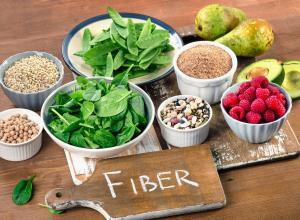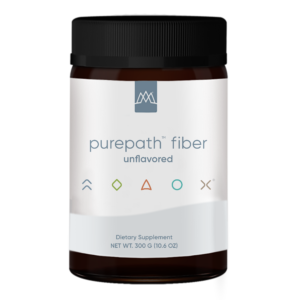Fiber is essential to keep you regular. Sufficient amounts of dietary fiber improves the quality and quantity of bowel movements.
If irregular bowel movements or constipation become severe, it can lead to serious health concerns including heart problems and colorectal cancer. [1]
 The benefits of getting enough fiber are nearly endless. Numerous studies show that fiber can reduce the risk of many diseases, including:
The benefits of getting enough fiber are nearly endless. Numerous studies show that fiber can reduce the risk of many diseases, including:
- Obesity
- Type 2 diabetes
- Cancer
- Heart disease [2]
Researchers have found through studies that populations who eat more fiber have less chronic disease and fiber intake significantly lowered risk of total death in both men and women. [3] [4]
Still not convinced? Consider these five benefits of increasing your fiber intake and how important it is to your overall health.
- Weight loss. For people who are obese, research shows that using a fiber supplement significantly enhances weight loss. [5] Sufficient amounts of fiber can improve satiation and less likely to reach for seconds at the dinner table. Fiber can also slow the rate that carbohydrates absorb into the bloodstream, preventing glucose or blood sugar levels from spiking too quickly.
- Minimizes toxins. Toxins are everywhere. In our food, water, air, and many products we use daily. Fiber binds to and absorbs toxins and other potentially harmful substances, eliminating them during bowel movements. [6]
- Supports the gut. Fiber passes through most of the gut undigested until it reaches the large intestine. There, bacteria ferment fiber, creating short-chain fatty acids (SCFAs). SCFAs are your colon’s primary energy source and can also lower inflammation to benefit the gut, immune system, and beyond.[7] Learn more about how gut health impacts overall health here.
- Improves depression. A high-fiber diet might help depression by lowering inflammation in the gut. [8] The gut plays key roles in brain health. For instance, about 90 percent of the body’s serotonin, a neurotransmitter that plays a role in mood and happiness. [9]
- Balances hormones. Fiber can bind excess amounts of hormones such as estrogen, excreting them rather than allowing them to circulate back in the bloodstream where they can cause problems. [10]
How Much Fiber Do You Need?
Dietary fiber is the edible parts of plants that resist digestion and absorption in the small intestine. (10) Fiber comes in two forms:
- Soluble fiber dissolves in water and can help normalize blood sugar and cholesterol levels.
- Insoluble fiber doesn’t dissolve in water and keeps food moving through your digestive system and supports regular bowel movements. [11]
Plant foods – foods like fruits, vegetables, nuts, and seeds – are good sources of both soluble and insoluble fiber. How much fiber you need depends on your age and gender. Current adult daily Dietary Reference Intakes (DRIs) for fiber are:
- Women age 19 to 50 years: 25 grams
- Men age 19 to 50 years: 38 grams
- Women age 51 and older: 21 grams
- Men age 51 and older: 30 grams [12]
Even with whole plant foods, you may not get sufficient fiber. A cup of green cabbage, for instance, contains 2.2 grams of fiber. A medium apple with the skin contains about 4.4 grams. [13] Eat your fruits and vegetables! They also contain a wide variety of important nutrients.
Most processed foods, including so-called healthy foods like whole wheat bread, contain little if any fiber. Juices are heavily processed and stripped of the fiber you find in whole foods. In fact, most people eat less than half the recommended amount of dietary fiber. For those who consume a low-carb diet such as keto diet, that amount could be even less. [14]
5 Easy Ways to Add More Fiber into Your Diet
Overall, research shows that only five percent of adults consume the recommended level of dietary fiber. [15] With a few simple strategies, you can easily fit more fiber into your diet.
Banish any ideas of boring, bland foods when it comes to stepping up your fiber intake! Most of the plant foods in our Core and Advanced Plans are high in fiber.
If you’re a fiber newbie, start slowly. Increasing your intake too quickly can cause stomach upset. As you gradually increase the amount of fiber, remember to drink plenty of clean, filtered water. Here are five more ways to easily fit more fiber into your day and get all of its benefits.
- Increase fiber superstars. Many foods that are high in fiber are also delicious and MaxLiving approved! A few fiber A-list foods include:
- Avocado (10 grams of fiber in one cup)
- Raspberries (8 grams of fiber in one cup)
- Artichokes (10 grams of fiber in one artichoke)
- Snack better. Nuts and seeds make convenient, crunchy, healthy snacks that are high in fiber. Our Trail Mix packs nuts, seeds, and healthy sweet ingredients.
- Add seeds to your smoothies. Start your day with a fiber boost! Our Nutrition Knock-Out Green Smoothie adds fiber-rich flaxseeds, but you can add these seeds to any smoothies.
- Eat your dessert. Not just any dessert! Our Almond Butter Pie Recipe is sinfully decadent, yet offers fiber-rich ingredients including almond butter and flaxseeds. No one will suspect that it’s healthy.
- Use a supplement. Even when you’re eating healthy, meeting your fiber quota can be a challenge. That’s why we created PurePath® Fiber. Most commercial fiber products contain just one type of fiber. In just two teaspoons per serving, 0urs provides 12, derived from vegetables, roots, seeds, and tree extracts.
What makes PurePath® Fiber the best supplement to increase your fiber intake.
- Many fiber products contain artificial sweeteners, colors, flavors, and fillers. PurePath® Fiber contains a blend of fibers sourced naturally from real foods.
- PurePath® Fiber is free of ingredients such as wheat dextrin and lactose, making it Paleo- and keto-friendly.
- PurePath® Fiber is unflavored and mixes easily into any liquid. You can also toss it into our smoothies, such as our Immunity Boosting Smoothie, to provide an easy fiber boost.
References
[1] https://www.ncbi.nlm.nih.gov/pmc/articles/PMC5038884/
[2] https://www.ncbi.nlm.nih.gov/pmc/articles/PMC3257631/
[3] https://pubmed.ncbi.nlm.nih.gov/26514720/
[4] https://www.ncbi.nlm.nih.gov/pmc/articles/PMC3513325/
[5] https://pubmed.ncbi.nlm.nih.gov/19335713/
[6] https://www.ncbi.nlm.nih.gov/pmc/articles/PMC6566984/
[7] https://www.frontiersin.org/articles/10.3389/fimmu.2019.02051/full#
[8] https://pubmed.ncbi.nlm.nih.gov/31750916/
[9] https://www.sciencedaily.com/releases/2019/09/190906092809.htm
[10] https://www.ncbi.nlm.nih.gov/pmc/articles/PMC3257631/
[11] https://www.hsph.harvard.edu/nutritionsource/carbohydrates/fiber/
[12] https://www.ncbi.nlm.nih.gov/books/NBK559033/
[13] https://www.ncbi.nlm.nih.gov/pmc/articles/PMC3649719/


